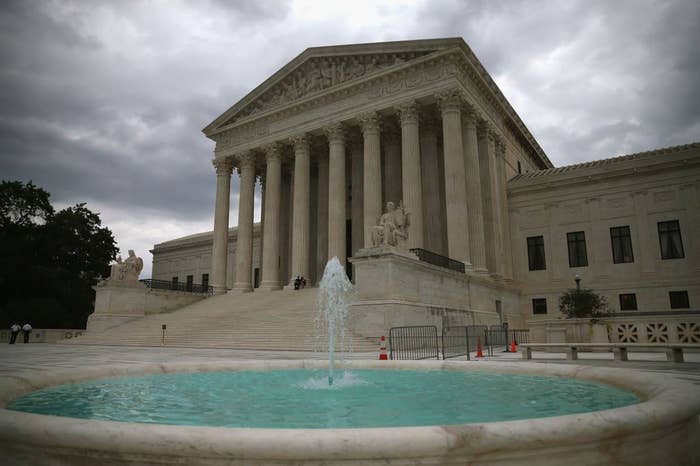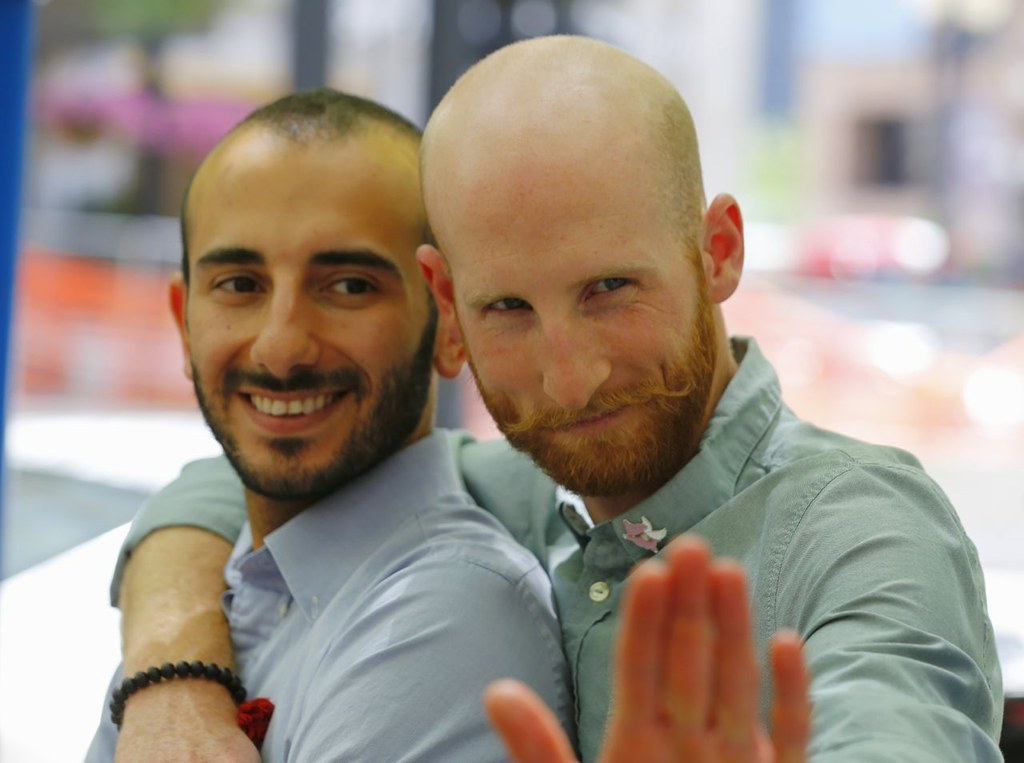
WASHINGTON — When the Supreme Court justices meet on Monday morning to formally begin the new term of the court, two of the highest-profile issues pending before the court are in cases that it hasn't yet decided to hear: same-sex couples' marriage rights and a major dispute over Obamacare subsidies.
The court is not required to hear most appeals, and this discretionary review in most cases means that parties first ask the justices to hear an appeal — a process referred to as a petition for a writ of certiorari. The marriage cases (a key issue for the political left) and the Obamacare dispute (a key issue for the political right) are still pending before the justices at the "cert stage," meaning that the two biggest decisions of the term, by next June, could be coming in cases not yet accepted by the court.
Outside of those cases, however, there are several other cases accepted by the justices that could have a major impact on American law — and Americans' lives.
From the type of discrimination that can be challenged under the Fair Housing Act — an issue the justices had tried to resolve last term, until a settlement was reached before the justices heard the case — to the way elections and redistricting work, the Supreme Court is due to decide several cases that have liberals concerned about the court's protection of minority rights under the tenure of Chief Justice John Roberts.
On the business side of the docket, there is a case that revolves around the question of whether Amtrak is truly a private company and another case that could have a big impact on protection of union retirees' health benefits. Another case pitting the Mortgage Bankers Association against the Labor Department could limit the ability of the administration to change its interpretations of regulations without first seeking outside comment on the change.
There are also several cases before the justices that will examine and, presumably, answer unresolved questions about the specific ways lawsuits alleging discrimination — several of them focused on religion-based claims — must be brought and the ways they can be defeated. The cases revolve around laws ranging from Title VII of the Civil Rights Act to the Pregnancy Discrimination Act to the Religious Land Use and Institutionalized Persons Act.
Although the marriage cases and the Obamacare lawsuits are getting the attention, in other words, there will be a lot of other cases heard in the coming months that could become blockbusters in their own right.

Nine of the Big Issues the Supreme Court Is Slated to Take on in the Coming Year:
1. Fair Housing Act: Texas Department of Housing and Community Affairs v. The Inclusive Communities Project
The question in this case is whether, under the Fair Housing Act's nondiscrimination provisions, actions, or policies that have a "disparate impact" — the outcomes of the actions or policies have a discriminatory effect even if they are not based in an intent to discriminate — are illegal under the federal law. This is an issue that the court has tried to take up on two prior occasions, but the cases have settled prior to the court being able to decide the question. The cert grant in the Texas case this past week "presents an opportunity for this court finally to resolve" the question, as Texas Attorney General Greg Abbott argued in his brief asking the justices to take the case.
The Department of Housing and Urban Development has issued a regulation clarifying its view that such "disparate impact" claims are allowed, and supporters of the law, including the National Fair Housing Alliance, have called the availability of disparate impact claims "essential" to "combating public or private actions that distort [housing] markets." A recent analysis from a Tulane Law School professor, however, showed that the success of such cases by plaintiffs already is quite limited. Nonetheless, she concluded that "the disparate impact method of proof remains a vital tool for accomplishing the elusive aims of the FHA."
2. Electoral Redistricting: Alabama Democratic Conference v. Alabama (Nov. 12); Alabama Legislative Black Caucus v. Alabama (Nov. 12); Arizona State Legislature v. Arizona Independent Redistricting Commission
The court has taken up two different redistricting questions this term. The first, being heard by the justices next month, centers around Alabama's 2012 redistricting and asks whether it amounts to "unconstitutional racial quota and racial gerrymandering." Alabama Democrats assert the state unconstitutionally created " excessively segregated election districts" through implementation of "a crude race-based policy in an area of exceptional constitutional sensitivity," but the state asserts the action — which resulted in supermajority-minority districts and fewer minorities in other districts — was required under the Voting Rights Act.
The second, in which the court accepted cert this past week, asks whether Arizona's "Independent Redistricting Commission," passed as a constitutional amendment by the voters, can handle redistricting or whether the Constitution requires the legislature itself to do so.
3. Elections: Williams-Yulee v. The Florida Bar; Ohio, Wisconsin, and North Carolina voter ID and registration cases
Even before the term technically started, the Supreme Court has already made news by issuing a stay last week that put Ohio's new restrictions on early voting back on the books for this November's election. Similar motions are pending before the justices from state officials in Wisconsin and North Carolina; those cases concern appeals court orders that barred implementation of Wisconsin's voter ID law and North Carolina's new voter registration restrictions. All of these cases are before the court now on limited questions about stopping lower court orders from going into effect, but the merits of the cases themselves could find their way before the justices this term as well.
Additionally, this past week the court announced it would hear a First Amendment case challenging Florida's law that bars judicial candidates in the state from personally asking for campaign donations.
4. Amtrak: Department of Transportation v. Association of American Railroads (Dec. 8)
Is Amtrak actually a private entity? The legal issue here relates to the "nondelegation doctrine," which prohibits Congress from delegating its lawmaking authority. Although Congress can delegate specifics to the executive branch under certain circumstances, if private entities have too much control that has led the court in the past to determine the delegation to be unconstitutional.
The private freight railroads' association says Amtrak is private, and, as such, it shouldn't be allowed "to co-author regulations governing private freight railroads." The government counters that it has maintains control over the "development and application" of the "metrics" in question — and maintains enough control over Amtrak itself — that it should not be considered "private" for this purpose.
5. Union Retirees’ Benefits: M&G Polymers USA, LLC v. Tackett (Nov. 10)
Under what circumstances should courts presume that union retirees are to continue receiving their health care benefits indefinitely? The various federal appeals courts across the country are split three ways on the question. One court has held if the collective bargaining agreement didn't address the issue, that means that the parties intended for the benefits to continue indefinitely; another court held a "clear statement" is needed that benefits are to continue indefinitely; and two other courts found a middle ground, deciding that some language in the agreement must exist to "reasonably support" the indefinite provision of benefits.
6. Labor Rules: Perez v. Mortgage Bankers Association (Dec. 1)
When a federal government department or agency puts in place new regulations, it must offer them up for a period of public notice and comment as part of the rulemaking process. The question in this case is whether the agency or department must engage in similar notice and comment when it wishes to change, not the regulation itself, but a change in an agency's interpretation of some part of a regulation. A decision that notice and comment is required could slow down agency changes of policy decisions and, in turn, decrease the likelihood of such changes being attempted. Although the Labor Department has filed its merits brief before the justices, the MBA is yet to file its brief.
7. Workplace Discrimination: Young v. UPS (Dec. 3); Mach Mining v. EEOC; EEOC v. Abercrombie & Fitch Stores
In a trio of cases, the court will consider specifics elements of various laws and the role of specific agencies in conjunction with discrimination cases. In Young, the justices will consider whether and when, under the Pregnancy Discrimination Act, a company — here, UPS — must provide work accommodations to pregnant women similar to accommodations it would provide to non-pregnant employees with similar work limitations.
Another case asks whether an employer — here, Abercrombie & Fitch — needs to have "actual knowledge" of a job applicant's need for a religious accommodation and whether that applicant must give "direct, explicit notice" that the religious accommodation is needed in order for the company's failure to do so to be a violation of Title VII of the Civil Rights Act of 1964.
Finally, in Mach Mining, the justices will consider whether and in what way courts can examine whether the requirement that the Equal Employment Opportunity Commission engage in "conciliation" efforts before bringing litigation has been met.
8. Religious Liberty: Holt v. Hobbs (Oct. 7)
In the first week of the court's new term, the justices are taking up a religious liberty question in the context of state prisons. Hearing the case of Gregory Holt, also known as Abdul Maalik Muhammad, they are considering his claim that the Arkansas prison system is violating the Religious Land Use and Institutionalized Persons Act by refusing to let him grow a half-inch beard in accordance with the requirements of his Muslim faith. Although more than 40 states allow such beards to be grown in prison, Arkansas officials have refused — citing safety and security concerns.
9. First Amendment: Reed v. Town of Gilbert, Arizona
Can Gilbert, Arizona, treat temporary signs relating to religious events differently than it treats political and ideological signs — or even than other event signs? And if the city does treat the signs differently, is that a "content-based" regulation subject to strict scrutiny, and, likely, unconstitutional? The Alliance Defending Freedom argues that it is unconstitutional in this long-standing case brought by Clyde Reed and Good News Community Church against Gilbert. The Department of Justice has weighed in, agreeing with ADF in arguing that Gilbert's regulations are unconstitutional. It adds, however, a contrast — its own signage regulations in the Highway Beautification Act — in order to show what this government views as "an example of a constitutional scheme of sign regulation." Gilbert is yet to file its defense of the regulations before the justices.

More About the Two Big Issues the Court Hasn’t Yet Decided to Hear:
Marriage:
In the biggest issue facing the justices, the court is yet to take any action on the seven requests about same-sex couples' marriage rights before it in cases from five states. The cases — out of Indiana, Oklahoma, Utah, Virginia, and Wisconsin — present the justices with the question whether states can ban same-sex couples from marrying. Although the court considered the question when dealing with California's Proposition 8 in 2013, it ended up avoiding answering the question — dismissing the appeal on technical grounds that the initiative's supporters, as opposed to state officials, couldn't bring the appeal.
Now, the court faces cert petitions from decisions of three different federal appeals courts, all of which struck down the bans. Arguments have been held in two other circuits, and cases are pending in still two other circuits. Marriage equality is the law in four of the remaining circuits, moreover, leaving only one appeals court — the 8th Circuit — without a case pending, a decision issued, or marriage equality currently legal within all states within its borders.
On Monday morning, the court could announce it has denied all the pending petitions, leading to marriage equality within the states in those three circuits. More likely, though the court will simply re-list the seven petitions in order to consider them again at the next (or a later) conference. Most court watchers expect the justices eventually to take up the issue this term — an incredibly quick turnaround since the court struck down the federal ban on recognizing same-sex couples' marriages in the Defense of Marriage Act in June 2013.
Obamacare:
The other issue, percolating in lower courts and before the justices, is the question of whether the subsidies available under Obamacare are available in states where people are using the federal exchange because their state did not set up an exchange. After three-judge panels of the 4th Circuit and D.C. Circuit courts of appeals differed on the answer to this question, the plaintiffs in the 4th Circuit case — in which the panel held that the subsidies were allowed under the federal exchange — filed a cert petition with the Supreme Court.
In the D.C. Circuit — in which the panel held that the subsidies are only available under state-created exchanges — the court there decided to hold an en banc rehearing of the case, which means all of the D.C. circuit judges will reconsider the case.
The Supreme Court could take the case out of the 4th Circuit now — or it could wait to see what the full D.C. Circuit and other courts with similar cases do with the subsidy question.
One of the cases referenced in the introduction to this story, Holt v. Hobbs, was initially left out of the numbered section of this article inadvertently.
